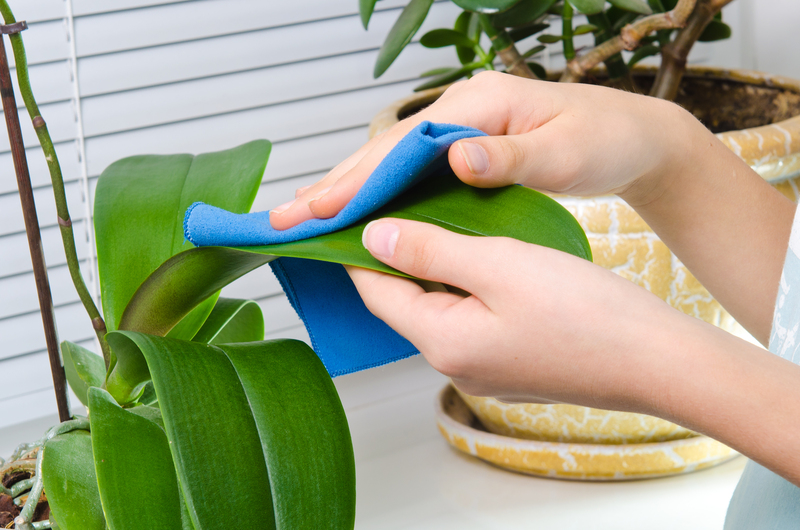Effective strategies for maintaining a mold-free bathroom environment
Posted on 22/09/2025
Effective Strategies for Maintaining a Mold-Free Bathroom Environment
Ensuring a mold-free bathroom environment is essential for a healthy home. Mold in bathrooms is a common problem due to the presence of high humidity, inadequate ventilation, and frequent water usage. Mold is not only unsightly, but it can also cause adverse health effects like allergies, respiratory problems, and skin irritation. This comprehensive guide delves into the most effective strategies for keeping your bathroom free from mold growth, preserving both the beauty and hygiene of your sanctuary.

Understanding Bathroom Mold: Why It's a Persistent Problem
It's important to understand why bathrooms are prime breeding grounds for mold. Mold spores are virtually everywhere, but they thrive and multiply rapidly in warm, damp, and less-ventilated spaces. Bathrooms frequently provide these perfect conditions due to steamy showers, running taps, spills, and occasional leaks.
- Humidity: High moisture levels in bathrooms, especially after hot showers, create an ideal environment for mold.
- Poor Ventilation: Limited airflow allows moisture to linger, increasing the likelihood of mold growth.
- Porous Surfaces: Grout, caulk, and wood can absorb and retain moisture, which encourages spore development.
- Neglected Cleaning: Infrequent cleaning allows mold spores to settle and take root in hard-to-reach places.
Maintaining a mold-free bathroom environment starts with recognizing these key causes and addressing them with targeted strategies.
Top Strategies for Keeping Your Bathroom Free from Mold
1. Improve Bathroom Ventilation
Proper ventilation is the cornerstone of a mold-resistant bathroom. Effective airflow reduces humidity and dries surfaces quickly, making it harder for mold to colonize.
- Use an Exhaust Fan: Install a high-quality exhaust fan and make it a habit to run it during and after showers for at least 20-30 minutes.
- Open Windows: If possible, open bathroom windows while bathing to allow moist air to escape and fresh air to circulate.
- Leave Doors Open: After using the bathroom, leave the door open to speed up moisture evaporation.
Optimizing ventilation is one of the most effective ways to deter mold formation in bathroom spaces.
2. Control Humidity Levels
Consistently monitoring and reducing humidity is essential for maintaining a mold-free bathroom environment. Mold typically thrives in humidity levels above 60%.
- Use a Dehumidifier: Place a small, portable dehumidifier in your bathroom if moisture is a recurring problem.
- Check Humidity with a Hygrometer: This device helps you monitor the moisture level in the air, ensuring it stays below 50%-55%.
- Fix Leaks Promptly: Address any dripping faucets, pipes, or showerheads immediately to prevent excess moisture accumulation.
Keep humidity low and you'll go a long way toward preventing the conditions mold needs to grow.
3. Regular and Thorough Cleaning Routines
Frequent cleaning is a proactive approach for a mold-free bathroom. Mold thrives on dust, soap scum, and grime.
- Scrub Showers and Bathtubs Weekly: Use mold-fighting bathroom cleaners, focusing on grout lines, caulking, and corners.
- Wash Bath Mats and Curtains Regularly: These fabric items can harbor mold if left damp. Launder or replace them often.
- Dry Surfaces: After each use, squeegee or wipe down wet tiles, glass, and fixtures.
By removing potential food sources and habitats for mold, you greatly reduce the likelihood of future mold blooms.
4. Seal and Maintain Grout, Caulking, and Tiles
Cracked or porous bathroom surfaces provide spaces for water and mold to accumulate. Ensuring all bathroom surfaces are properly sealed is a critical step in sustaining a mold-free bathroom environment.
- Routinely Inspect for Damage: Check grout lines and caulking for cracks, gaps, or signs of mold. Address issues immediately.
- Apply Fresh Sealant: Reseal grout and caulk every six months to a year, or as recommended by manufacturers.
- Choose Mold-Resistant Materials: When remodeling or repairing, opt for mold-resistant grout, caulk, and tiles.
An *airtight, well-sealed surface* is much less likely to host mold.
5. Address Plumbing Issues Quickly
Unresolved plumbing leaks or drips are major contributors to chronic bathroom dampness and mold problems.
- Identify and Repair Leaks: Listen for dripping sounds and inspect under sinks, behind toilets, and around showers for moisture or discoloration.
- Check Water Supply Lines: Tighten or replace worn connectors and hoses to reduce the risk of leaks.
- Clean Drains Regularly: Clogged drains can cause water to pool, creating ideal conditions for mold growth.
Timely plumbing maintenance prevents persistent dampness--the root cause behind many mold outbreaks.
6. Adopt Smart Bathroom Habits
Personal routines and habits also play a crucial role in keeping your bathroom mold-free.
- Hang Towels to Dry: Spread out towels after use and launder them often to prevent mold and mildew odors.
- Store Items Wisely: Avoid storing items directly on floors; use shelves for toiletries to allow air circulation.
- Remove Damp Items: Don't leave wet clothes, toys, or loofahs in the bathroom for extended periods.
With *simple daily habits*, you can reduce moisture and discourage mold growth dramatically.
Advanced Tips for a Mold-Free Bathroom Environment
Use Natural and Commercial Mold Inhibitors
- Vinegar Solution: Spray undiluted white vinegar on at-risk areas; allow it to sit for an hour before rinsing.
- Hydrogen Peroxide: A 3% hydrogen peroxide solution can kill surface mold in showers and sinks.
- Commercial Cleaners: Use mold and mildew removers designed for bathrooms, following the instructions carefully.
Design and Renovation Ideas to Prevent Mold
- Install Large, Easy-to-Clean Tiles: Fewer grout lines mean fewer places for mold to hide.
- Use Paints with Mildewcide: Special bathroom paints inhibit mold growth on walls and ceilings.
- Add a Window or Skylight: Natural light can help keep your bathroom drier and less prone to mold.
- Upgrade to a More Powerful Extractor Fan: Especially in bathrooms without windows, a high-capacity fan can make a significant difference.
Monitor Hidden Areas for Mold
- Look Behind and Under: Inspect under vanities, behind toilets, and around shower enclosures semi-annually for hidden problems.
- Check Ceilings and Walls: Bubble paint, discoloration, or musty odors can indicate mold behind drywall.
- Remove Unused Products: Minimize clutter in your bathroom as unused products can retain moisture and foster mold growth.
Health Risks of Mold in Bathrooms
Ignoring mold problems in your bathroom can significantly impact your family's well-being. Bathroom mold exposure can cause:
- Allergic Reactions: Sneezing, runny nose, skin rashes, and red eyes.
- Asthma Attacks: Mold spores can be particularly hazardous for people with asthma or bronchial issues.
- Chronic Fatigue: Inhaling mold toxins can lead to chronic tiredness and headaches in some cases.
- Infections: Immunocompromised individuals may develop fungal infections from prolonged mold exposure.
Proactively managing moisture and keeping your bathroom mold-free is crucial to safeguarding household health.
What to Do If You Discover Mold
If you spot mold despite your efforts, act quickly to prevent escalation. For small areas (less than 10 square feet), follow these steps:
- Wear Protective Gear: Use gloves, goggles, and a mask to avoid direct contact and inhalation.
- Clean with the Right Solution: Scrub affected areas with a cleaning agent such as vinegar, hydrogen peroxide, or a commercial mold remover.
- Dry Completely: After cleaning, use a fan or open window to dry the area thoroughly.
- Dispose of Contaminated Materials: Throw away heavily mold-infested porous items like shower curtains, mats, or drywall.
For large infestations or persistent mold issues, consult a professional, as hidden mold may require structural repairs.

Mold Prevention Checklist for Bathrooms
- Always use bathroom exhaust fans during and after bathing.
- Keep humidity below 50%-55% using dehumidifiers.
- Immediately dry wet surfaces and mop up spills.
- Clean and disinfect tiles, grout, and fixtures weekly.
- Routinely launder bath mats, towels, and shower curtains.
- Seal and repair grout and caulking as needed.
- Check for and fix leaks right away.
- Regularly check hidden spots for signs of mold.
- Ensure adequate natural light where possible.
- Declutter the bathroom for better airflow and easier cleaning.
Conclusion: The Key to a Mold-Free Bathroom Environment
Avoiding mold in your bathroom requires a bit of vigilance and a proactive approach. Begin by understanding the typical causes of mold growth in bathrooms, then consistently implement strategies that target ventilation, humidity, cleaning, and maintenance. Don't overlook the small details--simple shifts in your daily routine and timely action make a substantial impact.
Employing these effective strategies for maintaining a mold-free bathroom environment will reward you with a healthier, more pleasant space. Not only will you improve your bathroom's longevity and appearance, but you'll also protect your household from the health dangers of mold exposure. Make mold prevention a part of your regular home care, and your bathroom will remain sparkling clean and safe year-round.


